If you want to kill off a small-scale housing type, require “design review”—an official process for which developers must submit their building plans for review and public comment. That’s the main lesson of the five years of lowrise development in Cascadia’s largest city, Seattle, since it overhauled its regulations concerning multifamily neighborhoods in 2011.
That overhaul was intended by its proponents as tonic for better designed townhouses and rowhouses, and in many ways it succeeded. But it also precipitated a critical failure by suppressing the number—and raising the price—of new dwellings available for sale. More generally, Seattle’s 2011 multifamily regulation is a case study of the unintended consequences of innocuous-seeming housing rules.
Seattle’s lowrise profile
Seattle’s lowrise zones constitute 10 percent of the city’s land that is zoned for housing. Although the capacity for new housing in lowrise zones is small compared to the city’s higher-density zones, lowrise housing fills an important niche known as the “missing middle,” made up of duplexes, triplexes, rowhouses, and small apartment buildings: “missing,” because many growing cities such as Seattle offer little of it, and “middle,” because the square footage of housing per acre exceeds that in a single-family neighborhood but falls short of that in typical apartment zones. Missing middle housing offers an affordable entry to home ownership for young families and can also be a good fit for older people downsizing.
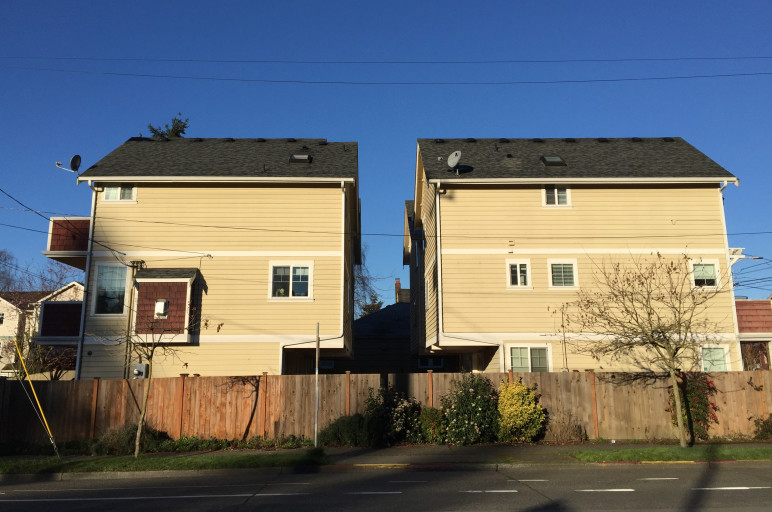
From the late 1980s until 2011, townhouse development ruled Seattle’s lowrise realms. The most common configuration, four duplex units looming over a shared driveway, became unaffectionately known as the “four-pack.” Widespread dissatisfaction with the four-pack and the desire for a greater variety of lowrise housing types catalyzed Seattle’s 2011 multifamily code update. Construction statistics since 2011 for lowrise housing show that more than half of lowrise dwellings built for sale during the period were clusters of single-family homes. Rowhouses made up 30 percent and townhouses just 15 percent of new, for-sale dwellings.
[table_container]
| For-sale Lowrise Housing Built Since 2011 | |||
| Project Type | Number of Projects | % of Total | Design Review Req? |
| Single-family Cluster | 393 | 52% | No |
| Rowhouse | 229 | 30% | No |
| Townhouse | 117 | 15% | Yes |
| Garden Courtyard | 9 | 1.2% | Yes |
| Terrace Courtyard | 11 | 1.4% | Yes |
[/table_container]
These figures reflect a sea change after the 2011 updates to the lowrise code: builders largely abandoned four-packs and most other kinds of townhouses in favor of single-family clusters and rowhouses. Most four-packs were ugly, it’s true, but the city threw out the baby with the bath water. Townhouses often yield more housing than any other type of lowrise housing that is available for sale rather than rental. More units typically means more money for developers, so you’d expect them to keep building townhouses. The main reason they stopped? The 2011 code says that townhouses must undergo what’s called “Streamlined Design Review,” an extended project review period during which neighbors are invited to submit written comments and city planning staff assess compliance with approved design guidelines.
The devil is in the Design Review
To the casual observer, design review probably seems like no big deal—after all, it’s just a requirement to pause briefly for design appraisal before breaking ground. But for builders, time is everything, and Streamlined Design Review can add several months to a typical townhouse project, along with a big serving of uncertainty over potential design changes that may be demanded. The housing market is impossible to predict more than 18 months out. In response, builders and their investors routinely opt for faster and more predictable timelines, even if doing so reduces their potential returns.
Instead of townhouses, builders opted for something that’s almost the same but remains exempt from design review. Over the same five years, construction of single-family (SF) clusters leapt from negligible to the head of the lowrise field. SF clusters are like four-packs, but you substitute small freestanding houses for the common-wall units in a townhouse development. Of all the lowrise types, SF clusters yield the fewest—and most expensive—homes per acre. Although each SF house commands a higher price than would a common-wall unit on the same site, SF clusters’ reduced number of units yields diminished profits for developers.

On the positive side, the 2011 code changes jumpstarted rowhouses. In a rowhouse, each home owns the land from the street face to the back of the lot—that is, unlike townhouses, they cannot be arranged with one building behind another, a constraint that limits the lot configurations that are feasible. The 2011 code loosened setback, depth, and width requirements that had previously rendered the rowhouse building type essentially impossible. But the new regulations did not impose design review on rowhouses.
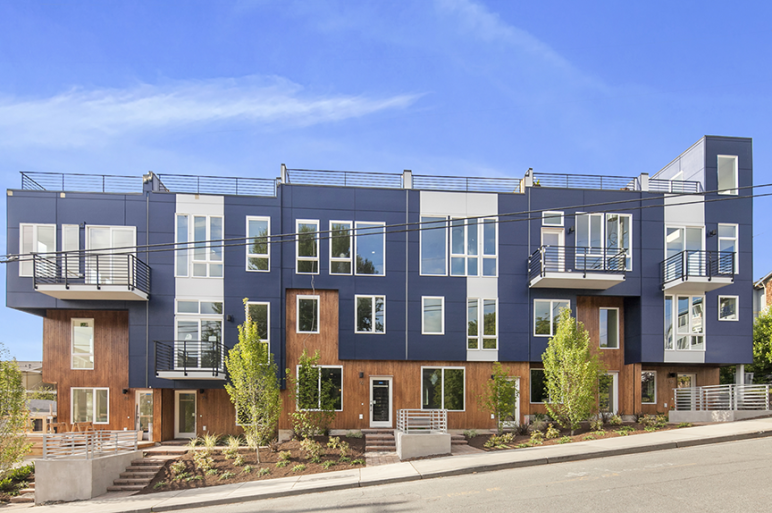
Despite the inherent limitations of positioning all units in a row at the sidewalk regardless of site topography and configuration, the exemption from design review still pushed rowhouse construction to twice the pace of townhouse construction over the past five years. That’s good news, because rowhouses can often yield as many new for-sale dwellings as townhouses, but they create a more appealing pedestrian environment with their street-facing entries and stoops, as opposed to the alienating, cavernous paved “auto-court” at the center of a typical four-pack. One downside, however, is that at the back of rowhouses, driveways and garages often take over area that would ideally be greenspace.
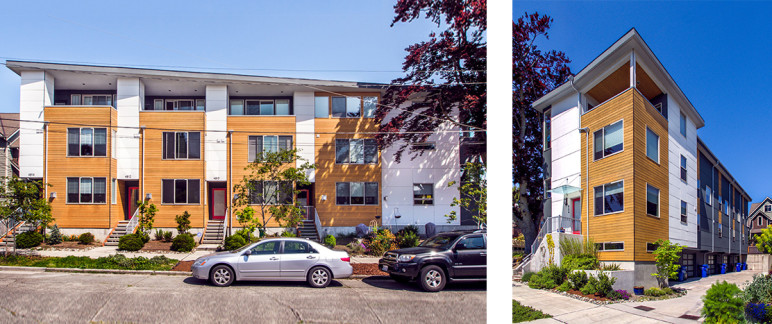
Indeed, the need to accommodate parking is the Achilles heel of all of the lowrise types. About half of Seattle’s residential blocks have alleys. For sites without alleys, the typical design solution dedicates significant interior site area to an auto-court, which has been the chief complaint against townhouses.

In contrast, for sites adjacent to an alley, parking can be conveniently located along it, leaving more space for people in a central “pedestrian court.” A little more than half of the 117 townhouse projects built since 2011 have pedestrian courts. Some builders have attempted to maximize these courtyards by consolidating units to create larger common open spaces—informally categorized as “Garden Courtyards” in the table above.
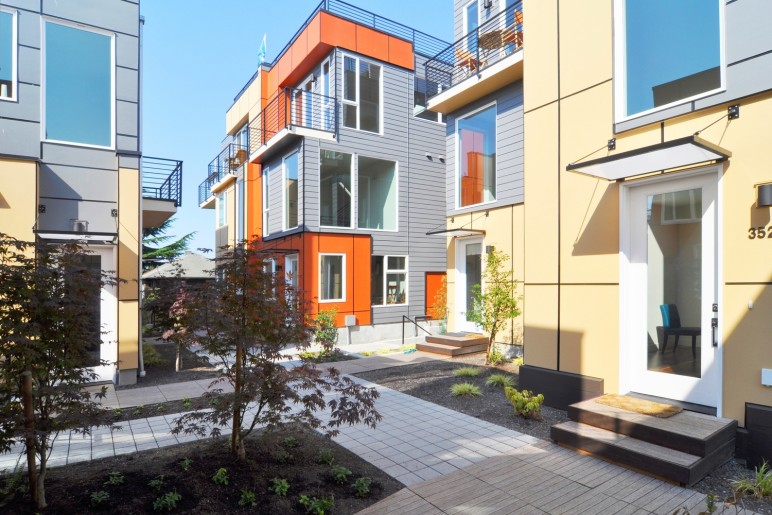
Another innovative approach to overcoming the challenge of parking is known as a “Terrace Courtyard.” This new design—unique to Seattle—covers the central driveways and parking area with a courtyard lid, transforming the center of the site from an automobile zone to useful open space for the residents. The Terrace Courtyard was made possible by the added design flexibility that came with the 2011 code update, and was recently recognized by the Puget Sound Regional Council with a Vision 2040 award. (Full disclosure: one of us, David Neiman, has designed most of the Terrace Courtyard townhouses in Seattle.)
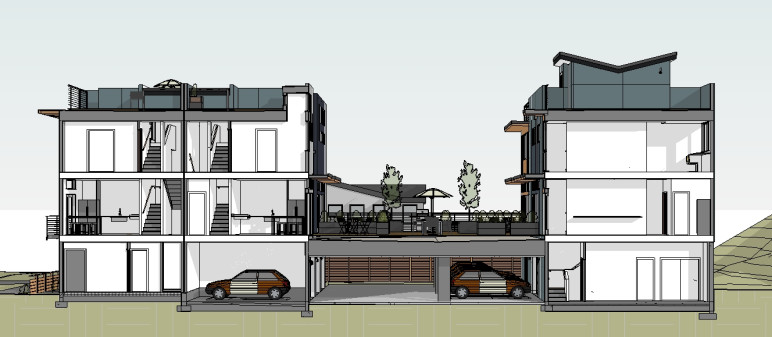
Although townhouses with pedestrian courts address the major quarrels most people have with four-packs, their rarity is the collateral damage of the blanket Streamlined Design Review requirement for all townhouse projects. Garden Courtyards and Terrace Courtyards are particularly unfortunate casualties, since these projects involve additional custom design effort, yet they still get dinged with design review—punishment for innovation.
[list_signup_button button_text=”Like what you|apos;re reading? Get the latest Sightline housing research right to your inbox.” form_title=”Housing Shortage Solutions Newsletter” selected_lists='{“Housing Shortage Solutions”:”Housing Shortage Solutions”}’ align=”center”]
Three Takeaways, Two Solutions, One Cautionary Tale
Five years’ data make clear three things: First, Seattle’s 2011 multifamily code update boosted rowhouses but decimated townhouses. Second, requiring design review quashed the auto-court four-pack but spawned something worse in its place—the auto-court single-family cluster offers the unappealing site layout of what it replaced plus less housing and higher prices. Third, design review obliterated not only its auto-court, four-pack target but all forms of townhouses, including ones that would otherwise be expanding Seattle’s housing stock without propagating ugliness.
Seattle’s low-rise story is a cautionary tale of the sensitive relationship between housing affordability and regulations.
The solution to this triumvirate of unintended consequences has two prongs. The first is simple: stop requiring design review for townhouses. Assuming that without the design review mandate developers would have built mostly townhouses rather than SF clusters, as they did before 2011, Seattle would currently have as many as 400 additional homes available for ownership, if it had never imposed design review on townhouses.
The second prong of the solution is to create incentives for courtyard townhouse designs. The city could, for example, allow extra floor area per lot to builders who choose Garden or Terrace Courtyard designs and provide shared open spaces equal to 15 percent of the lot area in their townhouse projects. Some may quibble that encouraging a parking structure runs counter to other Cascadian goals and that a better solution is to eliminate off-street parking requirements. We favor eliminating parking requirements. But even if parking is not required, most builders of ownership housing will still provide it, because buyers want it.
Seattle’s low-rise story is a cautionary tale of the sensitive relationship between housing affordability and regulations. The idea of design review (especially if “streamlined”!) sounds reasonable. Who would have suspected that it could swing the whole lowrise housing stock toward SF clusters and rowhouses?
And the same principles apply to larger housing projects that are subject to Seattle’s full-blown design review process. There is no getting around the fact that while design review may improve the appearance and integration of new buildings, the added delay and uncertainty inevitably lead to less housing and higher prices.
Seattle’s 2015 Housing Affordability and Livability Agenda (HALA) report recognized the connections between design review and affordability, and it recommended reforms to “improve predictability and consistency.” In response, the City of Seattle recently embarked on a project to “revamp and refresh” its Design Review Program.
Of course, design review is but one hurdle in the regulatory gauntlet for housing that developers must run. But all the hurdles add up, and municipal planners are known for having trouble finding the eraser end of their pencils. To be clear, tackling affordability doesn’t mean abandoning all regulations. But it does call for far more diligence in assessing the tradeoffs.
[button link='{“url”:”http://www.sightline.org/2015/07/13/hala-and-the-100000-question/”,”title”:”Want to learn more about Seattle|apos;s HALA plan? Click here.”}’]
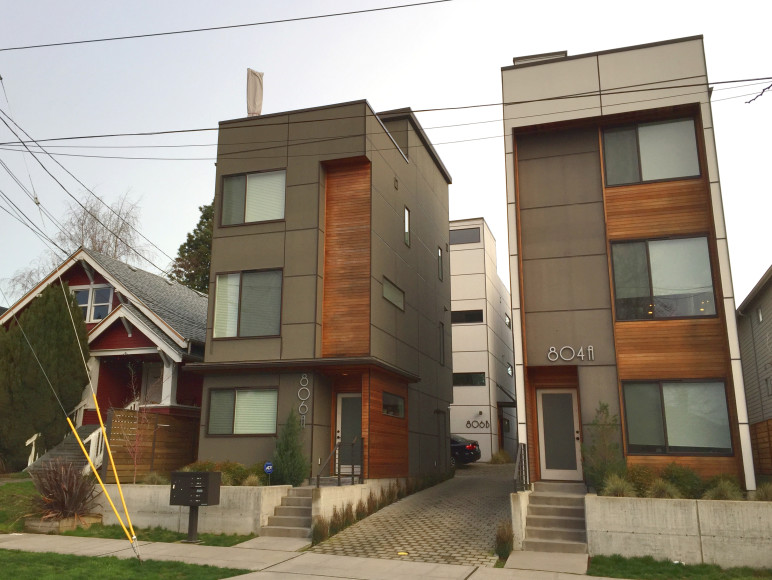

Comments are closed.